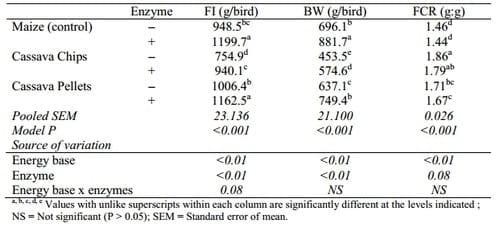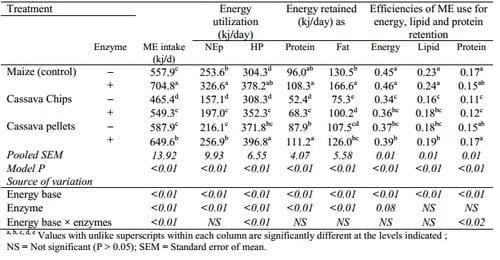SUMMARY
The objective of this study was to investigate the utilization of energy as well as performance of broiler chickens on diets based on cassava chips and pellets with or without enzyme supplements. Feed intake to day 21 was lower (P < 0.01) on the diet containing cassava chips than on diets with maize or cassava pellets, in spite of enzyme supplementation and enzyme supplements improved (P < 0.01) feed intake on all diets. Live weight at day 21 was also significantly reduced (P < 0.01) on the diet based on cassava chips but improved (P < 0.01) by the enzyme supplements. Metabolizable energy intake was reduced (P < 0.01) by both cassava chips and pellets but was improved (P < 0.01) on all diets by enzyme supplementation. A similar trend was observed for net energy of production (NEp), generally being higher (P < 0.01) on the maize-based diets than on diets containing cassava. Enzyme supplementation improved (P < 0.01) NEp. Heat production was highest (P < 0.01) on diets containing cassava pellets. In general, it may be possible to use cassava pellets in diets for broiler chickens at close to 50 % of the diet to reduce cost, and the nutritive value of such diets can be improved through supplementation with appropriate microbial enzymes.
I. INTRODUCTION
Cassava chips and pellets are two alternatives to cereal grains in cassava-producing areas for example, Asia or other regions that import these products. Both products are not currently used by the poultry industry in Australia but their use may increase as the pressure on grain supplies intensifies. In Asia and Africa cassava products are used in animal feeding to replace some or all of the cereal grain in diets for poultry. A study by Brum et al. (1990) showed that up to 66.7 % of maize in broiler diets can be replaced by cassava meal without adversely compromising growth performance. Other researchers have reported variable response on diets containing cassava products such as chips and pellets in broiler diets (Obikaonu and Udedibie, 2006). These inconsistencies may be due to differences in cultivars or product processing prior to feeding. In general, the utilization of energy in cassava products by poultry has not been extensively studied, particularly under controlled environments. This is an area that needs to be investigated, in order to position cassava as an alternative source of energy in poultry diets. The current research focused on improving carbohydrate digestion and energy value of cassava products in diets for broiler chickens.
II. MATERIALS AND METHODS
The two products, cassava chips and pellets, were received from Thailand and analysed for nutrient composition prior to feed formulation. The cassava chips and pellets contained (g/kg), CP 22, 21; crude fat 12, 15, and starch 750, 680. Lysine and methionine were (g/kg protein) 77, 75, and 17, 20 (g/kg protein) while calculated ME was 12.63 and 11.65 MJ/kg, respectively. The ME content of cassava chips and pellets was calculated according to the equation [ME (Kcal/kg) = 53+38 × (% CP + 2.25 × % EE + 1.1 × % Starch + % Sugar)] developed by Carpenter and Clegg (1956). In this trial, 384 one-day-old male Cobb broiler chicks were used in a 3 x 2 factorial design to compare the two cassava products (chips and pellets) with maize and with or without microbial enzyme (carbohydrase and phytase) supplementation. Each diet was replicated 8 times, with 8 chicks per replicate. The chicks were reared in cages in an environmentally controlled house. Semi-purified diets were formulated to contain the cassava products (50%) or maize (58%) as sole energy source in the diet with or without enzyme supplementation. All diets were iso-caloric and iso-nitrogenous. The ingredients were ground through a hammer mill, mixed to obtain a complete diet and then pelleted using a cold pelleter. The AME was measured through marker (TiO2)-based faecal collection between 18 and 21 days of age. The representative faecal sample was collected from each cage over three days, pooled, freeze-dried and analysed. At 21 days, 2 chicks per replicate were randomly selected and slaughtered through cervical dislocation. The carcasses were minced and a sub-sample was freeze-dried. The meat samples were analysed for energy, protein and fat contents. The diets and excreta samples were also analysed for these nutrients and TiO2.The data were used to calculate nutrient retention, net energy of production (NEp), heat production and efficiencies of utilization of metabolizable energy for protein, fat and energy retention as described by Olukosi et al (2008). Data were analysed in accordance with the general linear model of SPSS, version 18 (SPSS Inc, 2010).
III. RESULTS AND DISCUSSION
Feed intake up to d 21 was lower (P < 0.01) on the diet containing cassava chips than on diets with maize or cassava pellets, regardless of enzyme supplementation (Table 1). The enzyme supplements improved (P < 0.01) feed intake on all diets. Live weight at day 21 was also significantly reduced (P < 0.01) on the diet based on cassava chips but improved (P < 0.01) by the enzyme supplements. There was a significant increase (P < 0.01) in FCR in groups with the cassava products but this tended (P<0.08) to be improved by enzyme supplementation. The decrease in feed intake of the cassava chips-based diet may be due to the viscous nature of the cassava products, especially at high temperature. In solution, the material may create a gut-filling effect, thereby reducing appetite. However, the enzyme supplements improve feed intake in all diets, which is in agreement with the findings of Kumar and Dingle (1996) in research on cassava supplemented with a yeast product. There was an increase in live weight with the inclusion of enzymes, similar to reports by Akinfala et al., (2009) who observed a beneficial effect of feed additives in cassava-based diets fed to broiler chickens.
Metabolizable energy intake was reduced (P < 0.01) by both cassava chips and pellets but was improved (P < 0.01) on all diets by enzyme supplementation (Table 2). A similar trend was observed for NEp, generally being higher (P < 0.01) on the maize-based diets than on diets containing cassava. Enzyme supplementation improved (P < 0.01) NEp. Heat production was highest (P < 0.01) on diets containing cassava pellets and further increased (P < 0.01) by enzyme supplementation on all diets. This agrees with Iji et al., (2011) who reported that NEp and heat production were reduced by cassava pulp but were improved by enzyme supplements similar to those used in the present study. There may be a heat increment associated with further digestion of the product, even though that also led to an improvement in NEp. More (P < 0.01) energy was retained as protein and fat in the maizebased diets than on diets containing cassava and this was increased (P < 0.01) on all diets as a result of enzyme supplementation. The efficiencies of utilization of ME for energy, lipid, and protein retention were reduced (P < 0.01) by the cassava products but these were unaffected by enzyme supplementation.
In conclusion, it is possible to use cassava pellets in diets for broiler chickens at around 50 % of the diet. The nutritive value as well as efficiencies of utilization of nutrients of such diets can be further improved by use of appropriate microbial enzymes supplements.
Table 1. Feed intake, body weight and FCR of broiler chickens at 21 days of age on diets based on cassava products with or without microbial enzymes
Table 2. Metabolizable energy (ME) intake, net energy of production (NEp), heat production (HP), energy retained and efficiencies of ME use for energy, lipid and protein retention in broiler on the different diets with or without enzyme supplementation to 21 days
ACKNOWLEDGMENTS
We acknowledge funding and enzyme products from Danisco Animal Nutrition. The cassava products were supplied by Feedworks Aus. Pty. Ltd
REFERENCES
Akinfala EO, Matanmi O, Fatufe AA, (2009) Bulletin of Animal Health and Production in Africa, 57 (3), 269-276.
Brum PARD, Guidoni AL, Albino LFT, Cesar JS (1990) Pesquisa Agropecuaria Brasileira, 25, 1367-1373.
Carpenter KJ, Clegg KM (1956) Journal of the Science of Food and Agriculture 7, 45-51.
Iji PA, Bhuiyan MM, Chauynarong N, Barekatain MR, Widodo, AP (2011) Porceedings of the Recent Advances in Animal Nutrition Australia, 18, 115-120.
Kumar A and Dingle J (1996) Porceedings of Altech´s 12 Annual Sympoisum (lyon JP and Jacques KA Eds).
Obikaonu HO, Udedibie ABI (2006) International Journal of Agriculture and Rural Development 7, 52-55.
Olukosi OA, Cowieson AJ, Adeola O (2008) British Journal of Nutrition, 99 (3), 682-90.
SPSS Inc. (2010) Version 18.0.0. SPSS Inc., Chicago, USA.
This paper was presented at the 23rd Annual Australian Poultry Science Symposium, in Sidney, New South Wales from February 19-22, 2012. Engormix.com thanks the organizing committee and the authors for this contribution.












.jpg&w=3840&q=75)